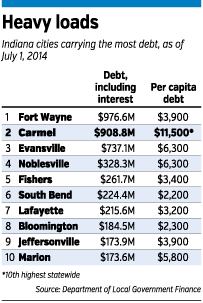Subscriber Benefit
As a subscriber you can listen to articles at work, in the car, or while you work out. Subscribe NowThere’s more than one way to calculate a city’s debt.
The issue has been at the heart of the mayoral campaign in Carmel this year, with incumbent Jim Brainard and challenger and Carmel City Council President Rick Sharp consistently citing different numbers and sources.
If you ask Brainard, he’ll include only the principal owed. If you ask Sharp, he’ll add the interest.
The differing approaches make a whopping difference. Brainard ballparks debt at $550 million. Sharp, who’s trying to cast the incumbent as an irresponsible big spender, says the tab is $1 billion.
It’s not unusual for differing definitions of “total debt” to crop up, and not just among political candidates, said Rachel Smith, an associate professor of finance at the University of Indianapolis.
“There are all kinds of ways you can slice and dice it,” she said.
Brainard’s calculation is compiled by Umbaugh, the city’s financial adviser, and includes county option income tax bonds, property tax bonds, utility bonds and Carmel Redevelopment Commission/general tax increment financing obligations.
Umbaugh partner Gerald Malone said he doesn’t count interest because that’s a factor of time. Bonds can be paid off early or refinanced and interest rates can change.
“That same philosophy and approach is consistent with the bond market,” Malone said of including only principal. “The interest isn’t due until the time has elapsed.”
Umbaugh’s calculation of debt rises to nearly $600 million if other long-term obligations are thrown in, such as leases for police cars and backup generators.

The larger figure also includes debt payable from tax-increment financing districts that developers have guaranteed. Brainard said he doesn’t count that debt since the city isn’t on the hook if tax revenue is insufficient to cover payments.
Data from the Indiana Department of Local Government Finance puts Carmel’s principal debt—including revenue bonds, utility bonds and notes, and loans payable—at $574 million as of Dec. 31.
The DLGF launched the debt-reporting tool in 2012. State law requires entities to report all debts held indirectly and directly, including redevelopment commission obligations and any bonds or leases.
The most recent DLGF report shows Carmel’s outstanding debt—including principal, interest and lease payments—is $913 million. That’s slightly higher than where Carmel stood at the end of 2014, when the DLGF reported Carmel’s debt at $908 million, second-highest in the state.
Sharp argues the city needs to consider interest because that’s the figure the city will have to pay.
“That’s what any sound fiscal policymaker would look at,” Sharp said.
Both Sharp and Brainard have compared this to buying a house or car, except each one uses that example in his favor. Smith said interest usually isn’t included when borrowers are evaluated. The principal is always there, so that’s what is considered.
Sharp said he’s citing DLGF data when he says debt is at $1 billion.
“It goes a bit lower, it goes a bit higher,” Sharp acknowledged.
Whatever the figure, Brainard and Sharp have sparred over whether the city’s debt is in check.
According to the DLGF, the debt per capita is $11,400, which ranks Carmel 10th-highest among Indiana cities and towns.
Most cities and towns with high per-capita debt are rural, where small debts can have a big per-capita impact.
Brainard, on the other hand, focuses on tax rates and praises Carmel for having one of the lowest in the state.
“It’s easy to say it’s too much debt, but how much is too much?” Brainard said, pointing to the city’s general bond rating of AA+ from Standard and Poor’s. “We wouldn’t have that if it was too much.”
The city received that rating about a year ago, and at the same time S&P boosted the rating on county income tax bonds from AA- to AA. S&P analysts cited the city’s growing county option income tax revenue and the strength of the underlying economy.
Smith said communities with stronger tax bases can generate more revenue without a sky-high tax rate.
One way to assess the burden on taxpayers is to calculate property taxes as a percentage of a county’s average income.
In Hamilton County, property taxes account for 2.44 percent of average income.
“We’re pretty much a model for good financial management,” Brainard said.
“The mayor is being completely disingenuous,” Sharp said.•
Please enable JavaScript to view this content.
